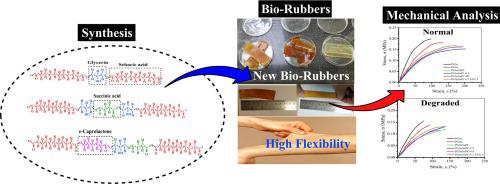European Polymer Journal ( IF 6 ) Pub Date : 2021-08-19 , DOI: 10.1016/j.eurpolymj.2021.110711 Samira Farjaminejad 1 , Shahrokh Shojaei 1 , Vahabodin Goodarzi 2 , Hossein Ali Khonakdar 3 , Majid Abdouss 4

|
In this research new types of biomaterials have been introduced. They are based on glycerin, sebacic acid, succinic acid and ɛ-caprolactone as their monomers. Their bio-nanocomposites were prepared with organo-montmorillonite (Cloisite 30B, C30B) and nano-hydroxyapatite (n-HA) by in-situ polymerization technique. Chemical, mechanical and biologocal properties of prepared samples were assessed by different tests. 1H NMR study showed that resin of polymeric chains poly(glycerol-sebacic) (PGSe), poly(glycerol-Sebacic-succinic) (PGSeSu) and Poly(glycerol-sebacic-succinic)-co-polycaprolactone (PGSeSuPC) were successfully synthesized. The results of dynamic contact angle test were showed that the presence of succinic acid and ɛ-caprolactone monomers in PGSe would provide attractive characteristics and the existence of nanoparticles would enhance the hydrophilicity of the samples. According to Dynamic mechanical thermal analysis (DMTA), it was determined that the storage modulus of samples which have been co-polymered by succinic acid and ɛ-caprolactone is higher than that of the PGSe at −40 °C and it is lower in higher temperatures. The existence of succinic acid and ɛ-caprolactone monomers have had softening effects on movement of PGSe chains. In tan(δ) behavior, the glass transformation temperature (Tg) for PGSe is about –7.6 °C and by co-polymerization with succinic acid and ɛ-caprolactone it changed to −11.8 °C and −26 °C respectively. Mechanical analysis on normal and degraded samples were done and their results showed that the presence of e-caprolactone into the bio-rubber’s backbone, has had significant effects on Young’s modulus and tensile strength. However, cyclic tensile test showed that hysteresis and residual strain of PGSeSuPC-C3 sample was higher than other samples. Hydrocatalytic degradation test explained that the existence of succinic acid monomer as an absorbent of water molecules, have enhanced the degradability, while the combination of nanoparticles of C30B and n-HA have had a positive influence on samples degradation.
中文翻译:

将琥珀酸和ɛ-己内酯单体添加到聚(甘油癸二酸)作为组织工程应用的主要平台,调节生物橡胶及其纳米复合材料的性能
在这项研究中,引入了新型生物材料。它们以甘油、癸二酸、琥珀酸和ɛ-己内酯为单体。他们的生物纳米复合材料是由有机蒙脱石(Cloisite 30B,C30B)和纳米羟基磷灰石(n-HA)通过原位聚合技术制备的。通过不同的测试评估了制备样品的化学、机械和生物特性。11H NMR研究表明,聚合物链树脂聚(甘油-癸二酸)(PGSe)、聚(甘油-癸二酸-琥珀酸)(PGSeSu)和聚(甘油-癸二酸-琥珀酸)-共聚己内酯(PGSeSuPC)均成功合成。动态接触角测试结果表明,PGSe中琥珀酸和ɛ-己内酯单体的存在将提供有吸引力的特性,纳米颗粒的存在将增强样品的亲水性。根据动态机械热分析 (DMTA),确定琥珀酸和 ɛ-己内酯共聚的样品在 -40 °C 时的储能模量高于 PGSe 的储能模量,并且在较高的温度。琥珀酸和 ɛ-己内酯单体的存在对 PGSe 链的运动具有软化作用。晒黑(δ)行为,玻璃化转变温度 ( T g) PGSe 约为 –7.6 °C,通过与琥珀酸和 ɛ-己内酯共聚,它分别变为 -11.8 °C 和 -26 °C。对正常和降解样品进行了力学分析,结果表明,ε-己内酯存在于生物橡胶的骨架中,对杨氏模量和拉伸强度有显着影响。然而,循环拉伸试验表明,PGSeSuPC-C3 样品的滞后和残余应变高于其他样品。加氢催化降解试验说明琥珀酸单体作为水分子吸收剂的存在,增强了降解性,而纳米颗粒C30B和n-HA的结合对样品降解产生了积极影响。


























 京公网安备 11010802027423号
京公网安备 11010802027423号